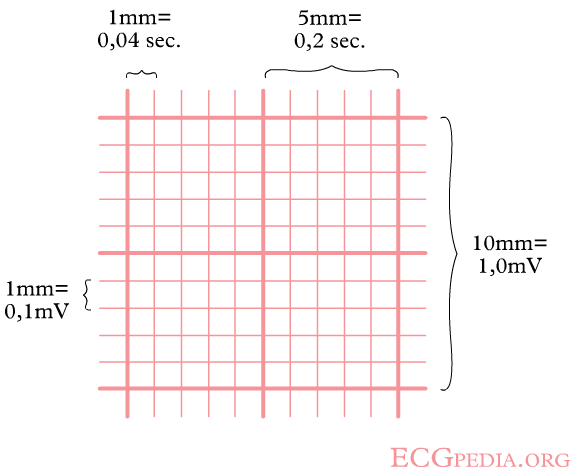Rate: Difference between revisions
Jump to navigation
Jump to search
mNo edit summary |
mNo edit summary |
||
| Line 11: | Line 11: | ||
To answer this question, determine the time between two QRS complexes. Previously, the ECG was registered on a paperstrip transported through an ECG writer at the speed of 25 mm/second. Nowadays, digital ECG registration is common however, the method of determining the frequency remains the same. The ECG paper has a grid with thick lines 5 mm apart (= 0,20 second) and thin lines 1 mm (0,04 second). | To answer this question, determine the time between two QRS complexes. Previously, the ECG was registered on a paperstrip transported through an ECG writer at the speed of 25 mm/second. Nowadays, digital ECG registration is common however, the method of determining the frequency remains the same. The ECG paper has a grid with thick lines 5 mm apart (= 0,20 second) and thin lines 1 mm (0,04 second). | ||
{| class="wikitable | {| class="wikitable" | ||
!There are three simple methods to determine the heart rate (HR) | |||
|- | |- | ||
| | |||
# To determine the frequency of a normal sinus rhythm Use the sequence 300-150-100-75-60-50-43-37. Count from the first QRS complex, the first thick line is 300, the next line 150 etc. Stop the sequence at the next QRS complex. When the second QRS complex is in between two lines, take the mean of the two numbers from the sequence or use the fine-tune method listed to the right. | # To determine the frequency of a normal sinus rhythm Use the sequence 300-150-100-75-60-50-43-37. Count from the first QRS complex, the first thick line is 300, the next line 150 etc. Stop the sequence at the next QRS complex. When the second QRS complex is in between two lines, take the mean of the two numbers from the sequence or use the fine-tune method listed to the right. | ||
# Count the small (1mm) squares between two QRS complexes. Hense, the ECG paper runs with 25 mm/sec through the ECG writer, therefore: [[Image:HFformule_en.png]]This method works well in case of tachycardia (>100 beats/minute)<br> | # Count the small (1mm) squares between two QRS complexes. Hense, the ECG paper runs with 25 mm/sec through the ECG writer, therefore: [[Image:HFformule_en.png]]This method works well in case of tachycardia (>100 beats/minute)<br> | ||
Revision as of 03:47, 8 February 2009
| «Step 1: Rhythm | Step 3:Conduction intervals (PQ, QRS, QT, QTc)» |
What is the heart rate?


To answer this question, determine the time between two QRS complexes. Previously, the ECG was registered on a paperstrip transported through an ECG writer at the speed of 25 mm/second. Nowadays, digital ECG registration is common however, the method of determining the frequency remains the same. The ECG paper has a grid with thick lines 5 mm apart (= 0,20 second) and thin lines 1 mm (0,04 second).
| 300 | 250 | 214 | 187 | 167 | 150 | 136 | 125 | 115 | 107 | 100 | 94 | 88 | 83 | 79 | 75 | 71 | 68 | 65 | 62 | 60 |
What changes the frequency of the heart?
A number of factors change the heart frequency including:
- the (para) sympathic nerve system.
- The sympathic system e.g. epinephrin (=adrenalin) increases the atrioventricular conduction and contractility. (the fight, fright, flight reaction)
- The parasympathic system (nervus vagus) e.g. acetycholin decreases the frequency and atrioventricular conduction. The parasympathic system effects mainly the atria.
- Cardiac filling increases the frequency.
- Also arrhythmias influence heart rate.